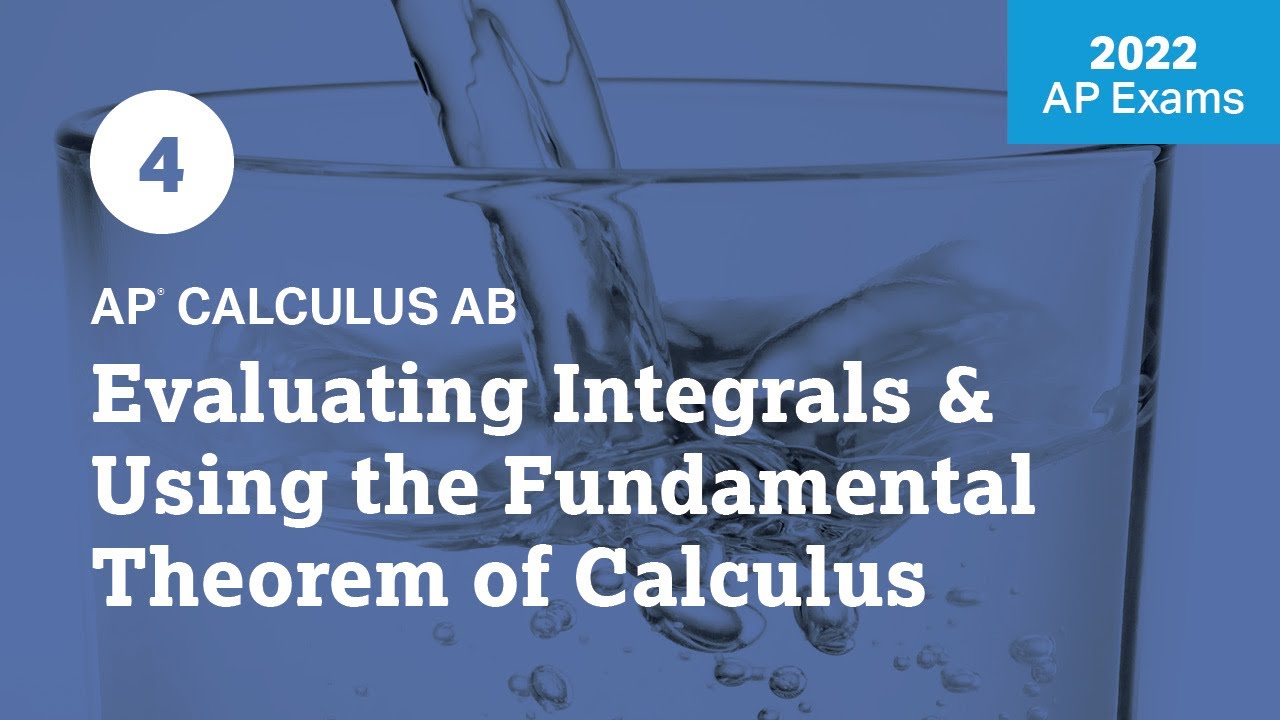2022 Live Review 3 | AP Calculus AB | How to Find Limits & Continuity
TLDRThe provided transcript captures an engaging and informative session on calculus, hosted by two educators, Marge and Mark. They delve into a variety of calculus topics, including limits, continuity, and derivatives, with a particular focus on applying these concepts to solve problems. The session is structured around a series of questions that progressively challenge the students' understanding of calculus principles. Marge and Mark use a combination of analytical and synthetic approaches, including L'Hôpital's rule and the concept of differentiability, to tackle the problems. They emphasize the importance of recognizing indeterminate forms and the utility of the fundamental theorem of calculus, which is set to be discussed in a subsequent session. The educators also highlight the significance of creating personal study guides and practicing problems to solidify understanding. Throughout the session, they maintain an interactive and humorous tone, making the complex subject of calculus more accessible to students.
Takeaways
- 📚 Start with understanding the function: The session emphasizes the importance of grasping the nature of the given function before attempting to solve problems, highlighting the need for a conceptual understanding over reliance on calculators.
- 🔍 Identifying discontinuities: The speakers discuss how to determine the types of discontinuities (vertical asymptotes and removable discontinuities) in a function, which is crucial for understanding its behavior.
- 🧮 L'Hôpital's Rule: The application of L'Hôpital's rule is explained in the context of limits that result in an indeterminate form, showcasing a method for finding limits when direct substitution is not possible.
- 📉 Asymptotes and Derivatives: The session touches on the relationship between the graph of a function, its asymptotes, and how these relate to the derivative, which is a key concept in calculus.
- 🤔 Continuity and Differentiability: The importance of continuity and differentiability is stressed, with examples provided to illustrate how to check for these properties in piecewise functions.
- 📈 The Limit Definition of the Derivative: The script explains the concept of the derivative using the limit definition, which is fundamental to understanding rates of change in calculus.
- 🧬 Cofunctions and Derivatives: A note on cofunctions and their derivatives is provided, highlighting a common pattern that can be memorized for quick problem-solving.
- ∫ Definite Integrals: The conversion of limit expressions into definite integrals is discussed, which is a key technique for evaluating expressions that represent areas under curves.
- 🔁 The Fundamental Theorem of Calculus: A brief mention of the Fundamental Theorem of Calculus is made, setting the stage for a deeper exploration in subsequent sessions.
- 📌 One-Sided Limits: The concept of one-sided limits is introduced as a method to determine if a limit exists when direct substitution is not possible, which is a common technique in calculus.
- 📉 The Behavior of Functions at Discontinuities: The speakers discuss how to handle limits at points of discontinuity, emphasizing the need to examine the function's behavior from both the left and right.
Q & A
What is the main topic discussed in the video?
-The main topic discussed in the video is limits and continuity in calculus, with a focus on understanding and applying these concepts to various functions and problems.
What is the significance of the function f(x) = x^2 - 3x + 2 / (x^4 - 4x^2) in the discussion?
-The function f(x) = x^2 - 3x + 2 / (x^4 - 4x^2) is used as a warm-up problem to discuss vertical asymptotes and removable discontinuities, leading to the conclusion that the function has two vertical asymptotes and one removable discontinuity.
What mathematical rule is mentioned as a favorite by both speakers?
-L'Hôpital's rule is mentioned as a favorite by both speakers, which is a method for finding limits of indeterminate forms.
Why is it important to understand the concept of limits in calculus?
-Understanding limits is crucial in calculus as they are the foundation for understanding continuity, derivatives, and integrals. They are also essential for analyzing functions and their behavior as input values approach specific points.
What is the significance of the 'no calculator icon' in the context of the video?
-The absence of a calculator icon indicates that the problems must be solved by hand, which requires a deeper understanding of the concepts involved rather than relying on computational tools.
What is the derivative of the function p(x) = -sin(x) according to the video?
-The derivative of the function p(x) = -sin(x) is cos(x), as the video discusses the limit definition of the derivative and the need to differentiate one more time.
How does the video emphasize the importance of practice in learning calculus?
-The video emphasizes the importance of practice by encouraging viewers to pause the video and work on the problems themselves before checking the provided solutions. It also suggests doing all practice problems first and then watching the video to compare results.
What is the role of the unit circle in understanding trigonometric limits and derivatives?
-The unit circle is a valuable tool for visualizing and memorizing the values of trigonometric functions, especially when dealing with limits and derivatives, as it helps to quickly identify the correct values for sine and cosine at specific points.
Why is it suggested to create a personal study guide when preparing for an exam?
-Creating a personal study guide is suggested because it helps students to organize and understand the material in their own way, reinforcing their learning and providing a tailored resource for review.
What is the purpose of the multiple-choice format in the video's problem-solving approach?
-The multiple-choice format allows for a more focused approach to solving problems, as it provides specific answer options that can guide the problem-solving process and help identify the correct solution more efficiently.
How does the video address the concept of piecewise functions in calculus?
-The video addresses piecewise functions by discussing their continuity and differentiability, using them in limit problems, and emphasizing the importance of understanding how the different segments of the function behave at the points where they join.
Outlines
📚 Introduction and Rational Function Analysis
The video begins with an introduction by two educators, Vurge Cornelius from Lafayette High School in Oxford, Mississippi, and Mark Corelli from Denton, Texas. They are on their third AP review for 2022 and start by discussing limits and continuity in calculus. They emphasize the importance of understanding these concepts not just for their application in calculus but also for how they are tested. The warm-up problem involves a rational function with a quadratic numerator and a quartic denominator, which they factor and analyze for vertical asymptotes and removable discontinuities.
🔢 Application of L'Hôpital's Rule and Asymptotes
The educators work through a problem involving the limit of a rational function as x approaches 2. They discuss the indeterminate form that arises from direct substitution and the application of L'Hôpital's rule. They also touch upon the concept of differentiating under the limit and the importance of confirming that the result is still in an indeterminate form. The discussion includes a graph analysis of a function with a vertical asymptote and a removable discontinuity.
🧮 Derivative Definition and Limit Evaluation
The conversation shifts to the limit definition of the derivative and the need to differentiate one more time to find the derivative of a function defined as the opposite of sine. They discuss the concept of cofunctions having negative derivatives and the importance of creating a personal study guide for exam preparation. The educators also cover a limit problem involving a sum from k=1 to n and translate it into a definite integral for evaluation.
📉 Continuity and Differentiability of Piecewise Functions
The educators analyze a piecewise function defined by sine and a linear function and discuss its continuity and differentiability at a specific point. They differentiate the function and evaluate it at the point in question to confirm continuity and differentiability. They also emphasize the importance of understanding the smoothness of the function's transition between the different pieces of the piecewise function.
🧷 Finding Limits of Piecewise Functions
The focus is on finding the limit of a piecewise function as x approaches a critical value. The educators discuss the continuity of the function and how to find the value of a constant b that makes the function continuous. They use a calculator to find the intersection of the two parts of the piecewise function and emphasize the importance of checking for continuity and differentiability in such problems.
🤔 Limits Existence and One-Sided Limits
The educators explore the existence of limits for functions with discontinuities by examining one-sided limits. They demonstrate that if the left and right limits of a function at a point are equal, then the limit at that point exists. They apply this concept to a function defined as the sum of two functions, each with a jump discontinuity at the point in question.
🏞️ Definite Integrals and the Fundamental Theorem of Calculus
The video concludes with a discussion on definite integrals and a preview of the Fundamental Theorem of Calculus to be covered in the next session. They analyze a function defined as the integral of another function and find the value of the integral at a specific point. The educators also discuss the concept of derivatives as a measure of slope and how they relate to the graph of a function.
📝 Final Thoughts and Upcoming Topics
In the final segment, the educators summarize the key takeaways from the session, which include the importance of understanding limits, continuity, and the application of L'Hôpital's rule. They also provide guidance on how to approach problems with indeterminate forms and the significance of differentiability in relation to continuity. They outline the topics for the next session, which will cover integrals and the Fundamental Theorem of Calculus, and mention the release of answers for the week's practice problems.
Mindmap
Keywords
💡Limits
💡Continuity
💡Derivative
💡L'Hôpital's Rule
💡Rational Function
💡Asymptotes
💡Removable Discontinuity
💡Definite Integral
💡Fundamental Theorem of Calculus
💡Piecewise Function
💡Chain Rule
Highlights
The discussion begins with an emphasis on understanding limits and continuity in calculus, highlighting the importance of these concepts in pre-calculus and their applications.
The hosts, Vurge Cornelius Lafayette and Mark Corelli, introduce a problem-solving approach to a function involving vertical asymptotes and removable discontinuities, showcasing a hands-on method for rational functions.
Mark demonstrates the process of factoring to find zeros in the numerator and denominator of a function, which is crucial for determining asymptotes and discontinuities.
The concept of L'Hôpital's rule is introduced as a method for addressing indeterminate forms when finding limits, emphasizing its utility in calculus.
The hosts engage in a detailed analysis of a rational function to identify its vertical asymptotes and removable discontinuities, underlining the importance of factoring and understanding function behavior.
A unique approach to evaluating limits by first checking the denominator when substituting values, which can save time and effort in determining the viability of direct substitution.
The application of the limit definition of the derivative is explored through an example, illustrating the transition from a limit expression to a derivative function.
The hosts discuss the conversion of a limit expression into a definite integral, providing a clear example of how to translate a summation into an integral for evaluation.
An exploration of piecewise functions and their continuity and differentiability, offering insights into how to approach these functions when evaluating limits.
The use of L'Hôpital's rule is demonstrated in a multiple-choice format, showing how to efficiently apply the rule to find limits in the context of an exam.
The importance of understanding the limit definition of the derivative is emphasized through a common mistake and its correction, providing clarity on the concept.
The hosts provide a comprehensive review of limits, continuity, and differentiability in the context of piecewise functions, reinforcing these concepts with clear examples.
The concept of the derivative as a rate of change or slope is discussed, with an illustration of how to visualize this using tangent lines on a graph.
The application of the fundamental theorem of calculus is previewed in the context of evaluating definite integrals, offering a glimpse into the next day's lesson.
The hosts tackle a complex limit problem involving integrals and exponents, demonstrating a step-by-step approach to resolve indeterminate forms.
The session concludes with a summary of key takeaways, emphasizing the importance of understanding limits, continuity, and the application of L'Hôpital's rule.
The hosts encourage students to practice and review, highlighting that grasping these mathematical concepts is achievable with consistent effort.
Transcripts
Browse More Related Video

8 | FRQ (No Calculator) | Practice Sessions | AP Calculus AB

2021 Live Review 3 | AP Calculus AB | How to Find Limits & Continuity

1 | MCQ | Practice Sessions | AP Calculus AB

2021 Live Review 1 | AP Calculus AB | Understanding Derivatives & Chain Rule

2022 Live Review 5 | AP Calculus AB | Focusing on the Big Theorems Including IVT, EVT, & MVT

2022 Live Review 4 | AP Calculus AB | Integrals & Using the Fundamental Theorem of Calculus
5.0 / 5 (0 votes)
Thanks for rating: